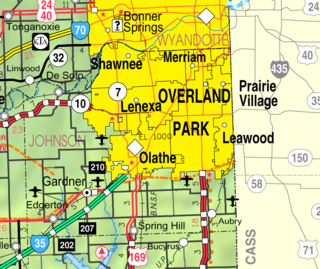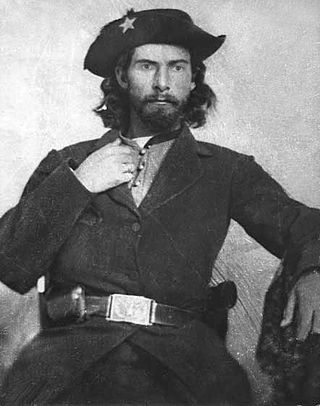
Douglas County is located in the U.S. state of Kansas. As of the 2020 census, the county population was 118,785, making it the fifth-most populous county in Kansas. Its county seat and most populous city is Lawrence.

Eudora is a city in Douglas County, Kansas, United States, along the Kansas and Wakarusa rivers. As of the 2020 census, the population of the city was 6,408.

Lawrence is the county seat of Douglas County, Kansas, United States, and the sixth-largest city in the state. It is in the northeastern sector of the state, astride Interstate 70, between the Kansas and Wakarusa Rivers. As of the 2020 census, the population of the city was 94,934. Lawrence is a college town and the home to both the University of Kansas and Haskell Indian Nations University.

Olathe is the county seat of Johnson County, Kansas, United States. It is the fourth-most populous city in both the Kansas City metropolitan area and the state of Kansas, with a 2020 population of 141,290.

Shawnee is a city in Johnson County, Kansas, United States. It is the seventh most populous municipality in the Kansas City metropolitan area. As of the 2020 census, the population of the city was 67,311.

Quantrill's Raiders were the best-known of the pro-Confederate partisan guerrillas who fought in the American Civil War. Their leader was William Quantrill and they included Jesse James and his brother Frank.

William Clarke Quantrill was a Confederate guerrilla leader during the American Civil War.

Vinland is an unincorporated community in Douglas County, Kansas, United States. It is located south of Lawrence and north of Baldwin City.

The Lawrence Massacre, also known as Quantrill's Raid, was an attack during the American Civil War (1861–65) by Quantrill's Raiders, a Confederate guerrilla group led by William Quantrill, on the Unionist town of Lawrence, Kansas, killing around 150 unarmed men and boys.

William T. Anderson, known by the nickname "Bloody Bill" Anderson, was a soldier who was one of the deadliest and most notorious Confederate guerrilla leaders in the American Civil War. Anderson led a band of volunteer partisan raiders who targeted Union loyalists and federal soldiers in the states of Missouri and Kansas.

At the outbreak of the American Civil War in April 1861, Kansas was the newest U.S. state, admitted just months earlier in January. The state had formally rejected slavery by popular vote and vowed to fight on the side of the Union, though ideological divisions with neighboring Missouri, a slave state, had led to violent conflict in previous years and persisted for the duration of the war.

Clinton is an unincorporated community on a peninsula next to Clinton Lake in Douglas County, Kansas, United States.
Louis Carpenter was a Judge in Douglas County, Kansas and was the highest ranking civic member of the town of Lawrence to be murdered by Quantrill's raiders during the Lawrence Massacre.

Globe is an unincorporated community in Douglas County, Kansas, United States. It is located along U.S. Highway 56 in Marion Township. To the west of Globe is the Simmons Point Station.

Lone Star is an unincorporated community in Douglas County, Kansas, United States. It is located 7 miles (11 km) southwest of Lawrence.
Franklin is a ghost town in Douglas County, Kansas, United States. Established as a proslavery stronghold, the town played a key role in the "Bleeding Kansas" conflict that troubled the territory in the 1850s.
Louisiana is a ghost town in Douglas County, Kansas, United States.

The Eldridge House Hotel is a historic building located on Massachusetts Street, in downtown Lawrence, Kansas. The building is named after Shalor Eldridge, a prominent anti-slavery individual who erected the building in the mid-1800s. The building, as its contemporary name suggests, is currently used as a hotel.

Samuel Jefferson Jones was a pro-slavery settler who held the position of Douglas County sheriff in Kansas Territory from late 1855 until early 1857. He helped found the territorial capital of Lecompton and played a prominent role in the "Bleeding Kansas" conflict.
The skirmish near Brooklyn, Kansas was a skirmish of the American Civil War on August 21, 1863, between Quantrill's Raiders and pursuing Union forces immediately after the Lawrence massacre. James Henry Lane led a small group of survivors of the massacre in pursuit of Quantrill's men, and were joined by a force of about 200 Union Army cavalrymen, commanded by Major Preston B. Plumb. Lane's and Plumb's men fought with Quantrill's Raiders to the south of the town of Brooklyn, Kansas, which the raiders had burned. The Confederates began to panic, but a charge led by George Todd halted the Union pursuit. Quantrill's men escaped across the state line into Missouri and then scattered; a few were later caught and executed.



















